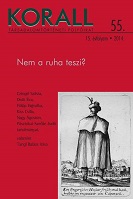Republikanizmus és csinosodás között. A nemzeti viselet és a politikai nyelvek 1790 körül
Between Republicanism and Improving Looks. National Dress and Political Language around 1790
Author(s): Ágoston NagySubject(s): History
Published by: KORALL Társadalomtörténeti Egyesület
Summary/Abstract: The topoi of Hungarian national dress emerged in literature to counter Emperor Josef II’s Germanisation efforts in the 1790s. Several authors, previously emphasizing the importance of commerce and improving looks in general, turned their attention towards the preservation of national characteristics around this time. Attitudes towards national dress have gained a political edge as part of the Hungarian nobility’s resistance movement. The transfer of the national crown to Buda, the death of Emperor Josef II, and the National Assembly of 1790–91 filled the country with jubilant sentiments. Political pamphlets increasingly focused on issues such as the constitution, language, religious tolerance and, first and foremost, national dress. The symbolic significance of national dress and the Hungarian crown is well illustrated by the significance attached to the uniform of the crown guards. The ideas about national dress, which became widely accepted and internalised by the resistance of the nobility in the 1790s, were originally formulated ten years earlier in the 1780s. These ideas fundamentally operated within the framework of the Republican political language, which emphasised masculinity, valour and simplicity in the discourse on national dress. In pamphlets expounding the importance of national dress the republicanism of Hungarian nobility three distinct aspects or argumentative techniques emerged, emphasising the nobility and simplicity of the forebears of Hungarian people: ‘Spartan Plutarchy’, patriotism for the ‘ancient constitution’, and the medieval idea of the Scythian heritage of the Hungarians. Republicanism among the Hungarian nobility associated foreign (mostly German) style with softness and visions of degeneration. This study interprets the political discourse about national dress and the crown guards’ uniform through the language of Republicanism and the agenda of “improving looks”. The study suggests that while in questions of the Hungarian national dress republican interpretations prevailed, the critique of the crown guards’ uniform was still fundamentally republican, but with elements like the agenda of ‘improving looks’ and economic rationale, which eschewed classical military values and found different criteria for the integration into political communities.
Journal: Korall - Társadalomtörténeti folyóirat
- Issue Year: 2014
- Issue No: 55
- Page Range: 22-45
- Page Count: 24
- Language: Hungarian

